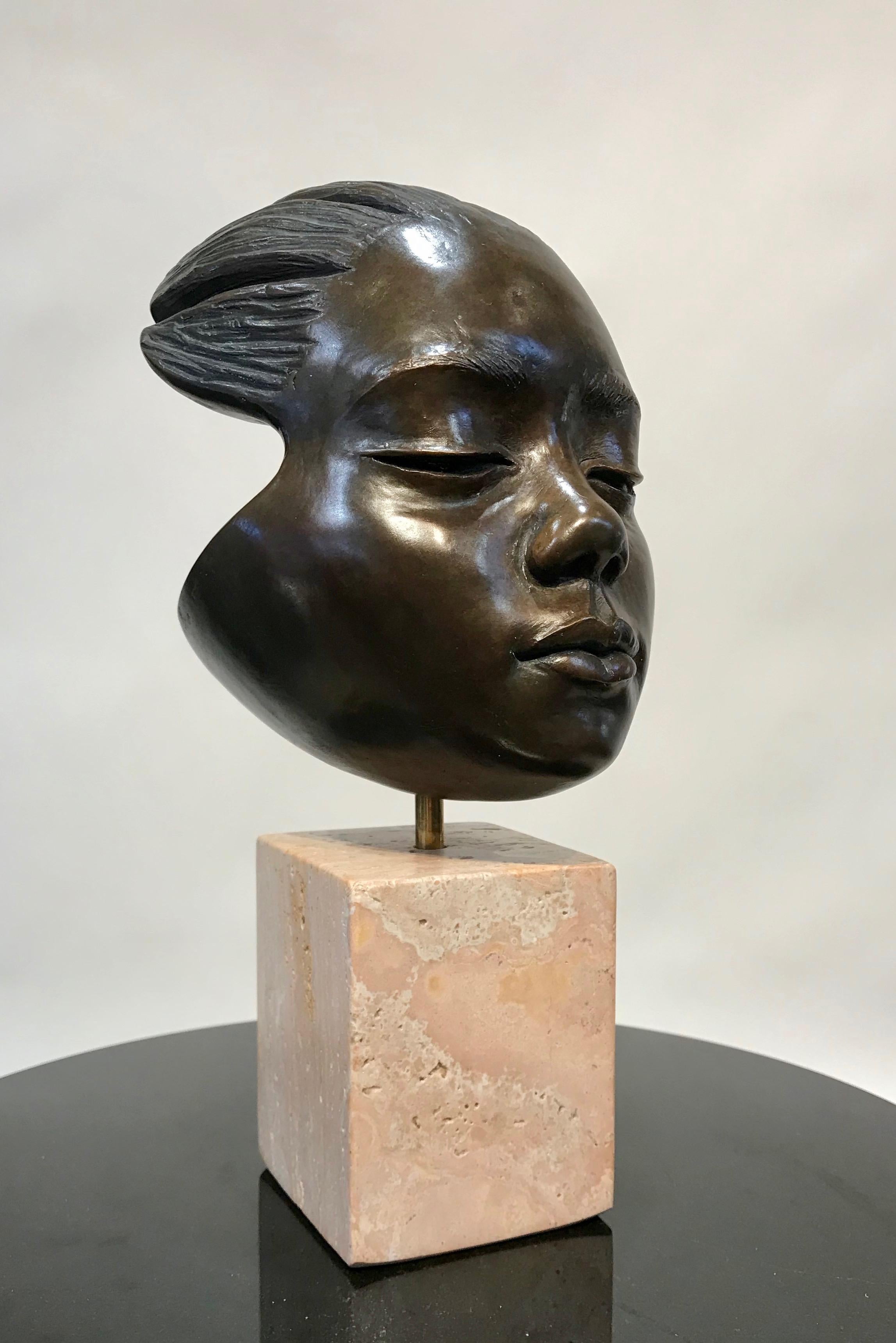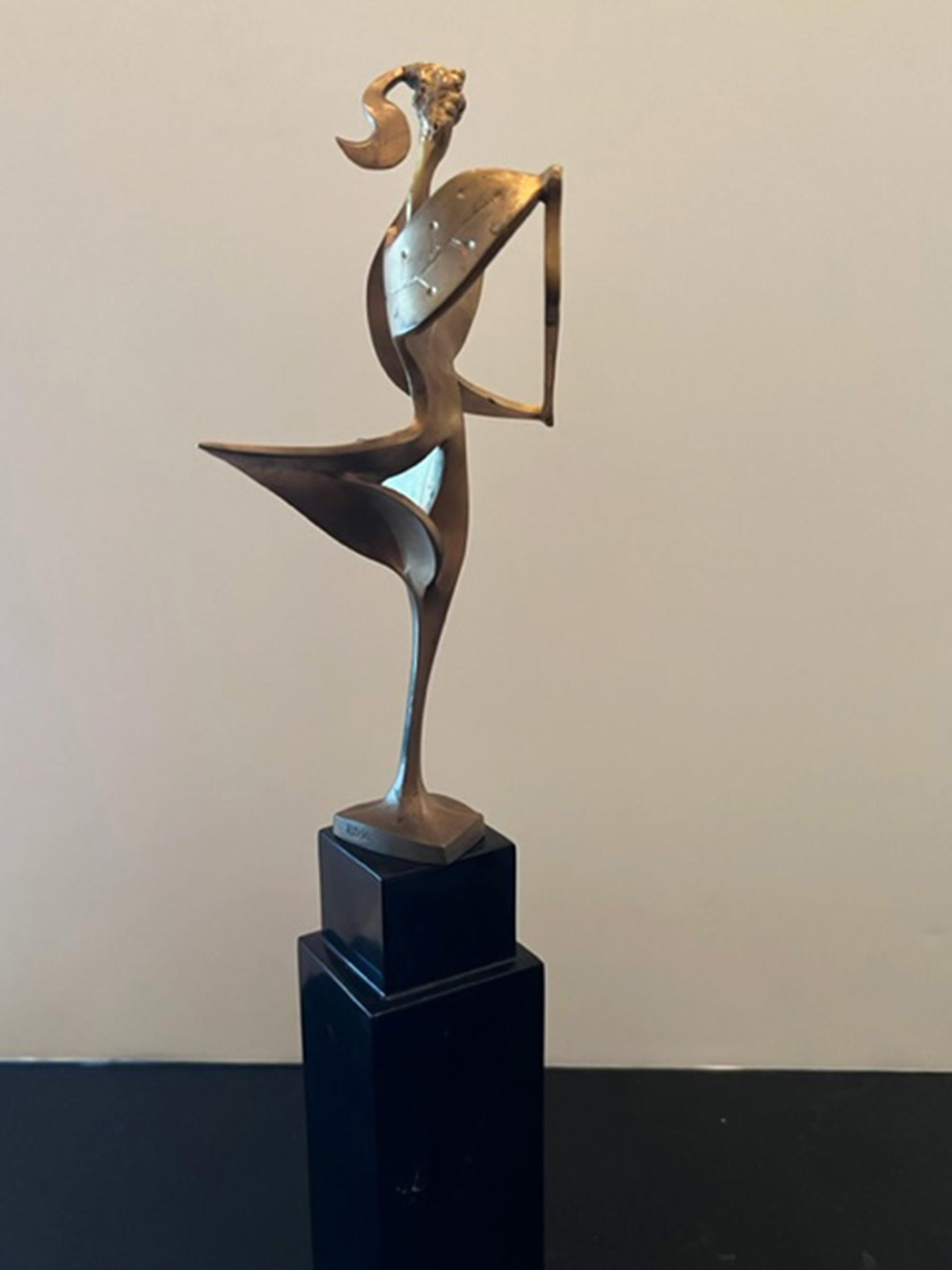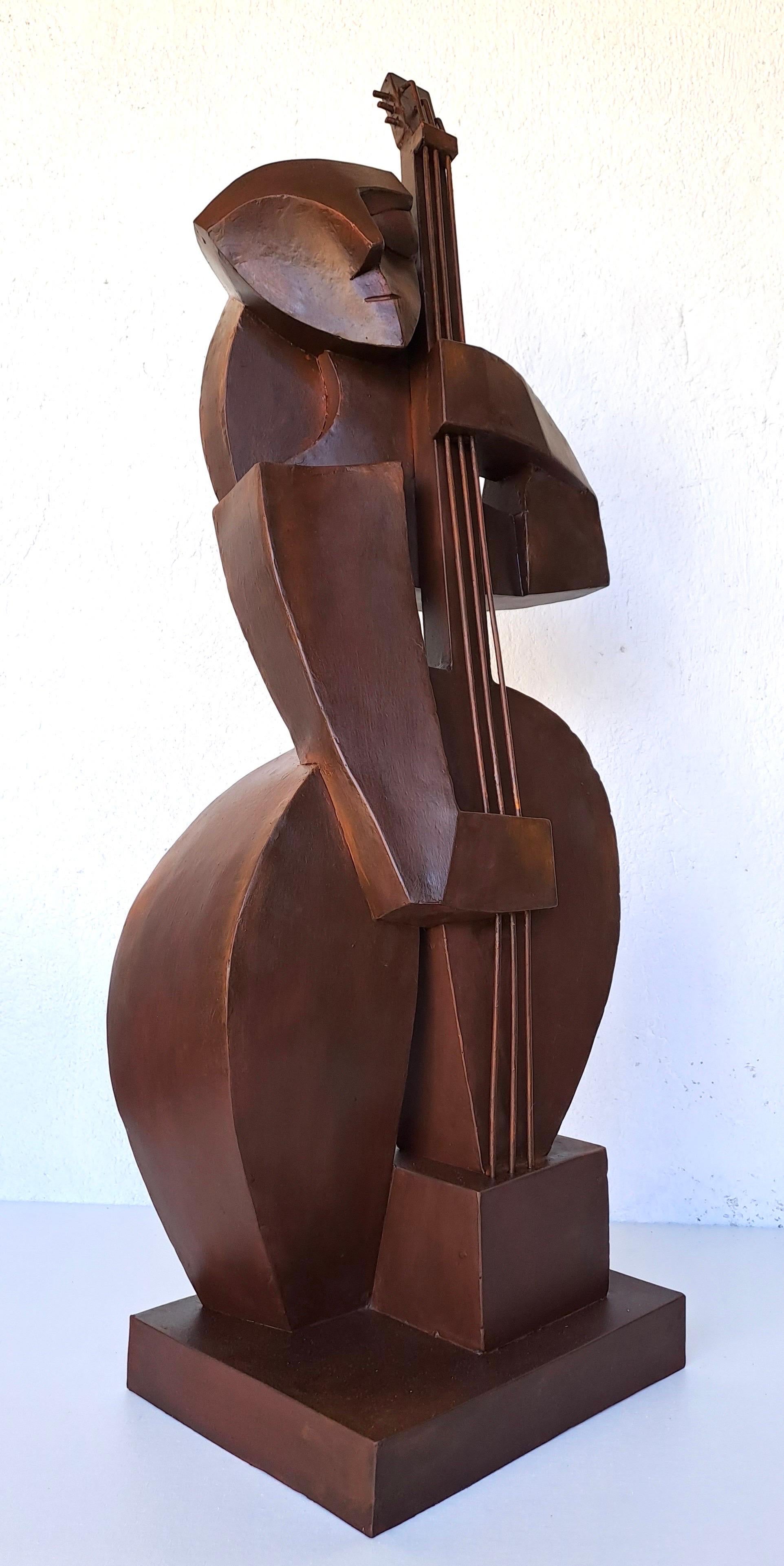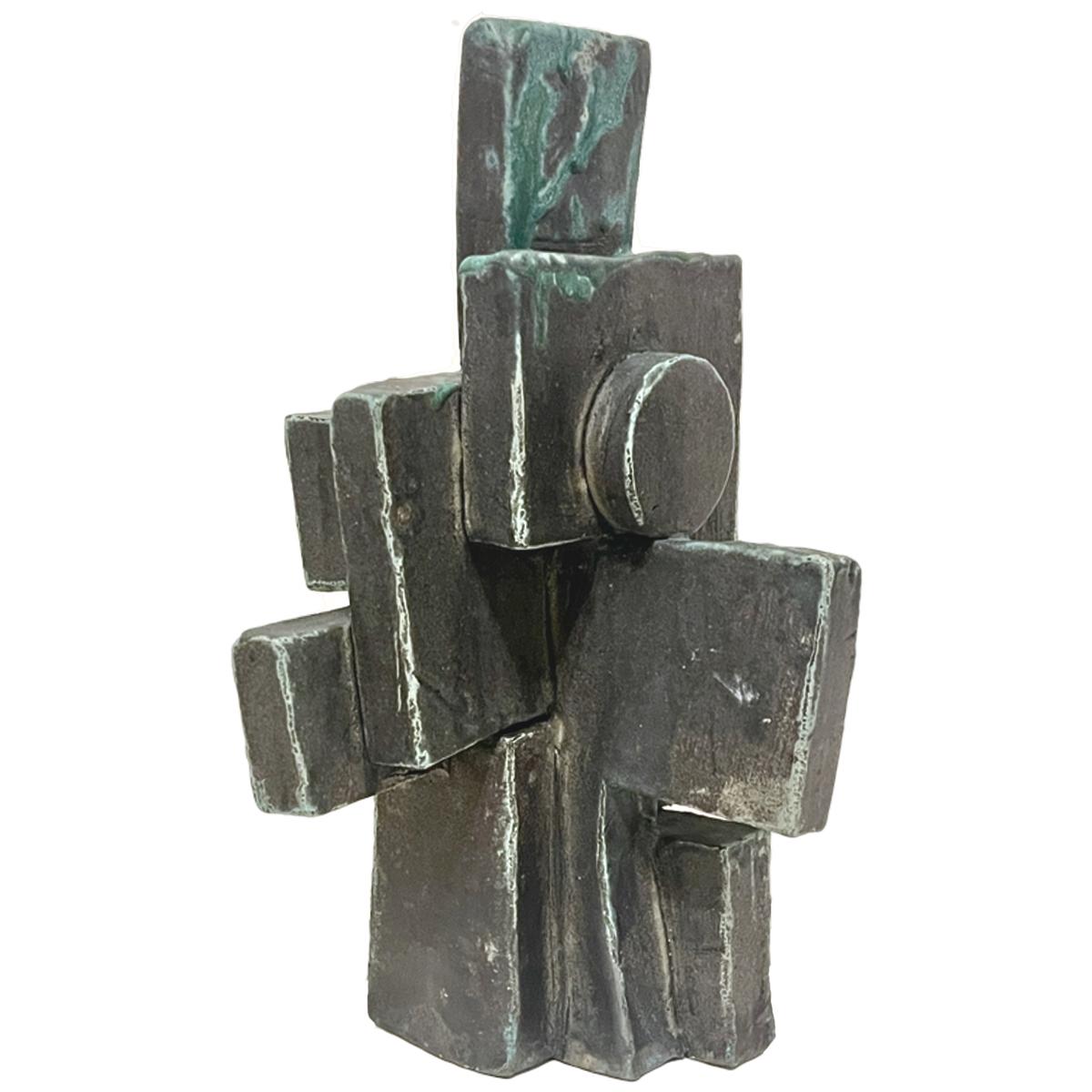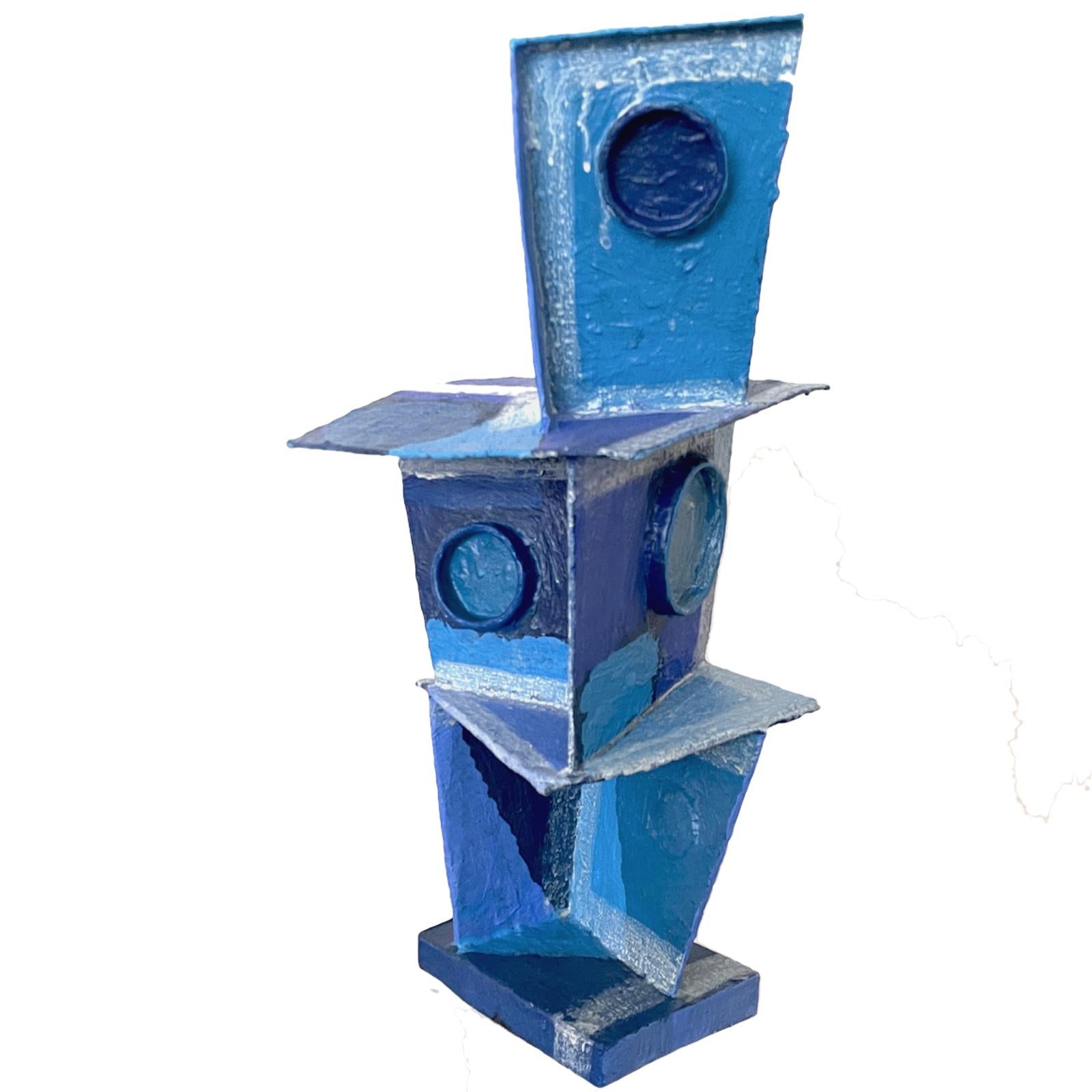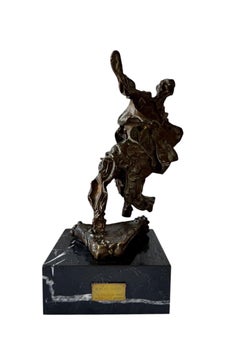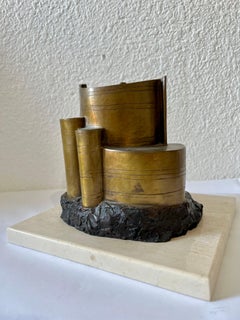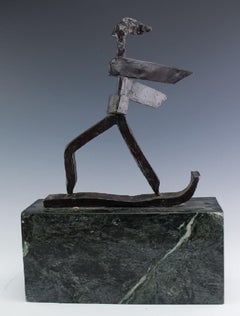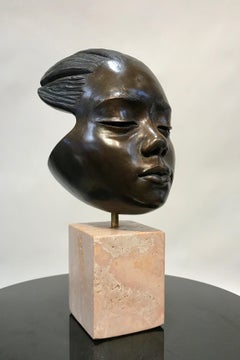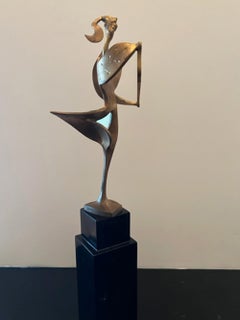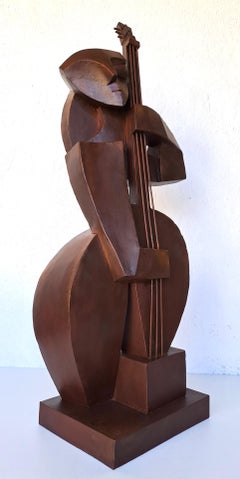Items Similar to Abstract Signed Cubist Bronze Sculpture "Cats" Chicago Bauhaus Woman Modernist
Want more images or videos?
Request additional images or videos from the seller
1 of 10
Marie Zoe Greene-MercierAbstract Signed Cubist Bronze Sculpture "Cats" Chicago Bauhaus Woman Modernistc.1960
c.1960
About the Item
This listing is just for the sculpture. (the picture of the ad is for reference and is not included.)
Marie Zoe Greene-Mercier was an artist, writer and arts activist who worked in the United States and Europe in the mid- to late-twentieth century. Educated at Radcliffe College, Greene-Mercier was also a student at the New Bauhaus School of Design in Chicago. Greene-Mercier worked in a variety of media, but was best known for the abstract metal sculptures she produced in the 1950s-1970s. An American artist born to French immigrant parents, Greene-Mercier studied art at Radcliffe College. A working artist since the 1940s, Greene-Mercier began to produce primarily large, abstract sculptures cast in bronze in the 1950s. She began creating small- and large-scale works in the heavier “Cubic” style in the late 60s, and monumental sculptures in this mode would characterize her work in the 1970s.
Marie Zoe Greene-Mercier was born March 31, 1911 in Madison, Wisconsin. Both of her parents were French immigrants; her father, Louis J.A. Mercier, served on the faculties of University of Wisconsin and Harvard University before returning to France to serve in World War I. Greene-Mercier described her family life during this time as "itinerant," but stability returned after the war. As a child, Greene-Mercier attended Catholic schools in the Boston area. After high school, she studied and traveled in Europe before entering Radcliffe College, where she earned a bachelor's degree in fine arts in 1933.
Greene-Mercier's early career included work as a French teacher at Loyola University, an art critic, and assistant positions at the Renaissance Society and the Art Institute of Chicago. In 1936, she began working as a French film reviewer for the International Film Bureau, a Chicago-based distributor of educational and foreign films. In 1937, she married the firm's owner, Wesley Hammond Greene. She began her association with the New Bauhaus School of Design in the same year, taking classes from 1937-1938. Greene-Mercier studied at the Institute of Design under Laszlo Moholy-Nagy, Alexander Archipenko and Gyorgy Kepes. influenced by Jacques Lipchitz at Modern Art Foundry, Long Island City, NY
Greene-Mercier was the recipient of numerous awards, including the 1969 International Grand Prize for Modern Sculpture. Her sculptures took abstract forms, from flowing, overlapping lines of bronze to shiny stacked cubes.
The 1940s brought both the birth of Greene-Mercier's first two children, as well as the beginning of serious exposure as an artist, working in collage and sculpture. Marie-Zoe Greene-Mercier is best known for her grandly-scaled monumental sculpture, such as the two French Government commissions at Barcarès and Arras. Less well known is a series of collages in which she explored the spatial relationships created by separating paper and other materials by multiple panes of glass, which she has named 'polyplane collages. She also exhibited figural sculptures, particularly idealized human heads and faces: Among these works are two sculptures of Greene-Mercier's sister-in-law, the actress Dame Judith Anderson.
In the early 1950s, Greene-Mercier began to produce primarily large, abstract sculptures cast in bronze. She worked in two formal styles, which she described as "Arboreal" and "Cubic." From 1953 to the late 1960s, her work was predominantly in the linear "Arboreal" style, represented by Multiplication of the Loaves and Fishes and the series Orpheus. She began creating small- and large-scale works in the heavier "Cubic" style in the late 60s, and monumental sculptures in this mode would characterize her work in the 1970s.
Greene-Mercier also continued to create small paintings, collages, reliefs and drawings throughout her career. In 1969, three collections of her drawings of European cities were published by Libreria Internazionale Italo Svevo as Trieste: 101 Disegni; Venezia: 101 Disegni; and Salzburg: 101 Zeichnungen.
In North America, Greene-Mercier exhibited primarily in Chicago and Canada, At the height of her career in the United States, she participated regularly in solo and group exhibitions in venues such as the Renaissance Society, the Art Institute of Chicago, and the Arts Club of Chicago. However, her work found greater representation and larger audiences in Europe, with solo exhibitions held in Paris, Athens, Rome, Florence, Venice, Milan, and West Berlin (A retrospective exhibition of her work was held in 1977 at Amerika Haus, Berlin). Her monumental sculptures were installed as public art in France and Germany.
Greene-Mercier participated in several Chicago-based arts organizations, including the Chicago Society of Artists, the Renaissance Society, the Arts Club of Chicago, the Hyde Park Art Center, and the 57th Street Art Fair. She was also active in Chicago's Alliance and Maison Française. In 1956, Greene-Mercier began working with the Chicago chapter of the Artists Equity Association, advocating for the legal rights of artists. She served as president of the organization from 1959-1961. Another important aspect of her personal life was music; she studied violin in Europe, and the influence of music on her sculpture is evident in works such as the Orpheus series.
- Creator:Marie Zoe Greene-Mercier (1911 - 2001)
- Creation Year:c.1960
- Dimensions:Height: 26 in (66.04 cm)Width: 16 in (40.64 cm)Depth: 7.5 in (19.05 cm)
- Medium:
- Movement & Style:
- Period:
- Condition:good. minor wear.
- Gallery Location:Surfside, FL
- Reference Number:1stDibs: LU38214534712
About the Seller
4.9
Platinum Seller
Premium sellers with a 4.7+ rating and 24-hour response times
Established in 1995
1stDibs seller since 2014
1,744 sales on 1stDibs
Typical response time: 2 hours
- ShippingRetrieving quote...Shipping from: Surfside, FL
- Return Policy
Authenticity Guarantee
In the unlikely event there’s an issue with an item’s authenticity, contact us within 1 year for a full refund. DetailsMoney-Back Guarantee
If your item is not as described, is damaged in transit, or does not arrive, contact us within 7 days for a full refund. Details24-Hour Cancellation
You have a 24-hour grace period in which to reconsider your purchase, with no questions asked.Vetted Professional Sellers
Our world-class sellers must adhere to strict standards for service and quality, maintaining the integrity of our listings.Price-Match Guarantee
If you find that a seller listed the same item for a lower price elsewhere, we’ll match it.Trusted Global Delivery
Our best-in-class carrier network provides specialized shipping options worldwide, including custom delivery.More From This Seller
View AllOriginal 1969 Surrealist Bronze, Marble Sculpture Alma Del Quijote Salvador Dali
By Salvador Dalí
Located in Surfside, FL
Salvador Dali (1904-1989) –
Surrealist bronze sculpture by Salvador Dalí depicting an interpretation of the soul of Don Quiote. The sculpture is mounted on...
Category
1960s Surrealist Figurative Sculptures
Materials
Marble, Bronze
Bronze Abstract Space Age Book Sculpture LA California Modernist Charna Rickey
By Charna Rickey
Located in Surfside, FL
Charna Rickey 1923 - 2000 Mexican-American Jewish Woman artist.
Signed Bronze House of Books, Architecture Bronze sculpture, signed Charna Rickey and on the front "House of the book." It depicts an open Torah. Original patina.
Approx. dimensions: 7 in. H x 9 in. W x 8.5 in. D. Weight: 13.1 lbs.
Modernist Judaica Sculpture
Born Charna Barsky (Charna Ysabel or Isabel Rickey Barsky) in Chihuahua, Mexico, the future artist lived in Hermosillo and immigrated to Los Angeles when she was 11. She was educated at UCLA and Cal State L.A., she married furniture retailer David Rickey and explored art while raising their three daughters. Moving through phases in terra cotta, bronze, marble and aluminum, she found success later in life. Rickey became one of the original art teachers at Everywoman's Village, a pioneering learning center for women established by three housewives in Van Nuys in 1963. She also taught sculpture at the University of Judaism from 1965 to 1981.
As Rickey became more successful, her sculptures were exhibited in such venues as Artspace Gallery in Woodland Hills and the Courtyard of Century Plaza Towers as part of a 1989 Sculpture Walk produced by the Los Angeles Arts Council. Her sculptures have also found their way into the private collections of such celebrities as Sharon Stone.
Another of Rickey's international creations originally stood at Santa Monica College. In 1985, her 12-foot-high musical sculpture shaped like the Hebrew letter "shin" was moved to the Rubin Academy of Music and Dance at Hebrew University in Jerusalem. The free standing architectural Judaic aluminum work has strings that vibrate in the wind to produce sounds. Rickey also created art pieces for the city of Brea. They commissioned some amazing art pieces by Laddie John Dill, Walter Dusenbery, Woods Davy, Rod Kagan, Pol Bury, Niki de Saint Phalle, Magdalena Abakanowicz, Larry Bell, John Okulick...
Category
20th Century American Modern Abstract Sculptures
Materials
Marble, Bronze
Brutalist Modern Abstract Bronze Sculpture Metropolis Manner of Louise Nevelson
By Abbott Pattison
Located in Surfside, FL
A very heavy, massive bronze sculpture by an important Chicago sculptor. Signed and marked "Firenze" with "Fuse Marinelli". METROPOLIS. Seven abstract shapes on black marble base. 1...
Category
20th Century Modern Abstract Sculptures
Materials
Marble, Bronze
Kinetic Bronze Expressionist Sculpture Skier or Surfer Modernist Sporting Figure
Located in Surfside, FL
Vintage stylized figural sculpture by J James Akston (1898-1983 Poland/New York/Florida) Crafted of cast bronze with a rich dark brown patina. A sports figure, depicting a snow skii...
Category
Mid-20th Century Surrealist Abstract Sculptures
Materials
Marble, Bronze
Large Salvador Dali Surrealist Bronze Portrait Sculpture Mexican Master Aguilar
Located in Surfside, FL
Carlos Aguilar y Linares, Mexican Sculptor (1945-2010)
Sculpture chose him. In his hands and his soul he always had the necessary impulse to create wi...
Category
20th Century Surrealist Figurative Sculptures
Materials
Marble, Bronze
Large Latin American Modernist Bronze Abstract Cuban Master Roberto Estopinan
By Roberto Estopiñan
Located in Surfside, FL
Roberto Estopinan, Cuban, 1920 - 2015
Dimensions: 24.5" wide x 13" high plus 6" high base.
Roberto Estopiñán (1921–2015) was a Cuban American sculptor known for his sculptures of the human form, including political prisoners. Born in Camaguey, Cuba, he lived in the United States for over fifty years. His works are held by major institutions such as the Museum of Modern Art, the Whitney Museum and the Smithsonian Museum of American Art.
Roberto Gabriel Estopinan, a sculptor, draftsman, and printmaker, was born in Havana, Cuba on March 18, 1921. Estopiñán enrolled at the San Alejandro Academy when he was just 14 years old and became the protegé and studio assistant of the sculptor Juan José Sicre. After graduation he traveled first to Mexico, where he met and befriended Francisco Zuniga, and studied Pre-Columbian sculpture. In 1949 he traveled to Europe, visiting England, France and Italy. In these trips he encountered the sculpture of Henry Moore and Marino Marini, and their humanistic yet formal visions would be influential on Estopinan's work. Estopiñán was a pioneer of direct carvings using wood and of welding techniques in Latin America. Throughout the 1950s, Estopiñán received important prizes at various national exhibitions in Havana. In 1953 he was the only semi-finalist from Latin America at the Tate Gallery's international sculpture competition for a Monument to the Unknown Political Prisoner. In 1961, the artist moved to New York, where he resided until 2002.
Roberto Gabriel Estopiñán a Cuban emigre sculptor who emigrated to exile in the United States not long after Fidel Castro’s revolution in 1959, is considered one of Latin America’s most important 20th-century artists. His work, which includes drawings and prints as well as sculptures in wood and bronze, is in the collections of New York’s Museum of Modern Art, the Smithsonian’s American Art Museum, the Art Institute of Chicago, and the Detroit Institute of Art, among many locations. He is best known for his stark, disturbing renderings of political prisoners, the fruit of his own experiences as a dissident under both Castro and his predecessor, the dictator Fulgencio Batista, and for his representations of the female torso that can remind viewers of both classical statuary and the high-modern, abstractly elongated work of Henry Moore.mHe was born in Havana to a father from Asturias in northwest Spain and a mother of African descent. Estopiñán was something of a prodigy. At the age of fourteen, he won the first prize in drawing at the Centro Asturiano, a regional association for Cubans of Asturian descent. Shortly afterward he received special permission to enter the San Alejandro Academy of Fine Arts in Havana. At the school he was mentored first by its director, the painter Armando Menocal (1863-1941), then by the landscape artist Antonio Rodríguez Morey (1872-1967), and finally by Juan José Sicre (1898-1974), regarded as one of Cuba’s greatest sculptors. Sicre, a professor of sculpture at the Academy, had helped introduce European modernist art to Cuba, and from the 1930s through the 1950s had sculpted monumental figures in Havana of José Martí and other Cuban national heroes that stand to this day. Estopiñán was first Sicre’s student, then his assistant, and, finally, his colleague for the next fifty years. After graduating from San Alejandro in 1942, Estopiñán began simultaneously teaching art at the Ceiba del Agua School for young men, assisting Sicre in public art projects and developing his own artistic vision. He also traveled widely, to Mexico, New York, France, and Italy. From the late 1940s through the 1950s his sculpture evolved from an early neoclassical phase under the influence of Maillol to what he defined as “formalist humanism”: emphasizing the abstract beauty of the shapes he sculpted while not abandoning the human figure as the basis of his work. As the 1950s progressed he chose to carve in native Cuban woods...
Category
20th Century Abstract Figurative Sculptures
Materials
Bronze
You May Also Like
Listening, bronze sculpture, portrait of child, travertine base, contemporary
By Troy Williams
Located in Santa Fe, NM
Listening, bronze sculpture, childs portrait, limestone base, contemporary
limited edition bronze
Category
2010s Contemporary Figurative Sculptures
Materials
Travertine, Bronze
Primavera
By Robert Russin
Located in West Hollywood, CA
We are proud to present an original very early bronze, (1958) by American sculptor Robert Russin.
Robert Russin began his career as a WPA sculptor, and received dozens of commission...
Category
1950s Cubist Figurative Sculptures
Materials
Bronze
Price Upon Request
"Petit masque découpé Montserrat", 20th Century Bronze by Julio González
Located in Madrid, ES
JULIO GONZÁLEZ
Spanish, 1876 - 1942
PETIT MASQUE DÉCOUPÉ MONTSERRAT
signed "GONZALEZ"
5 of an edition of 9
Cire Perdue "C. VALSUANI" foundry seal
bronze...
Category
1930s Cubist Abstract Sculptures
Materials
Bronze
"BAJISTA"
By Ulises Jimenez Obregon
Located in Los Angeles, CA
ULISES JIMENEZ
"BAJISTA"
METAL, SIGNED
COSTA RICA, 2023
32.25 INCHES
Ulises Jiménez Obregón was born in La Mansion de Nicoya, Costa Rica, in November 1953.
He studied Plas...
Category
2010s Cubist Figurative Sculptures
Materials
Metal
Tall Weathered Bronze Ceramic Abstract Cubist Brutalist Totem Sculpture
By Judy Engel
Located in Hudson, NY
Hand built heavily glazed solid ceramic structure by NY artist Judy Engel.
Solid slabs create this cubist style sculpture that Engel is recognized for. Greatly influenced by the modernism of the middle of the 20th century, Judy's first introduction to this style was the Empire State Plaza in Albany, NY. "In the 1970s, upstate school kids...
Category
21st Century and Contemporary Cubist Abstract Sculptures
Materials
Ceramic, Glaze
'Blue Tone Tower': Modernist Vibrant Blues Cubist Sculpture by Bill Low
By Bill Low
Located in Hudson, NY
Cubist style abstract mixed-media sculpture titled 'Blue Tone Tower' was created using various materials including wood, papier-mache, and paint by Bill Low ...
Category
Mid-20th Century Cubist Abstract Sculptures
Materials
Wood, Paint, Paper
Recently Viewed
View AllMore Ways To Browse
Bauhaus Signed
Bauhaus 1960
Vintage Metal Sculptures Signed
Glass And Bronze Sculpture
Face Sculpture Large
Sculpture Of French Woman
Sculpture Two Faces
Bronze Face Sculpture
French 1950s Sculpture
High Relief Sculpture
Head Of A Woman Sculpture
A Mercier
Bronze Modernist Sculpture
Mid Century Abstract Bronze Sculpture
Berlin Bronze
Bronze Cat
Glass Face Sculpture
Glass And Bronze Sculpture French
